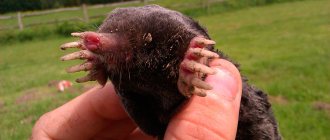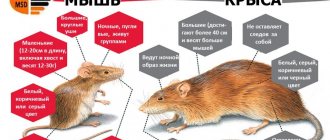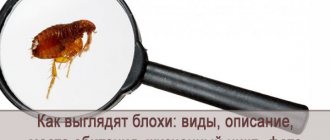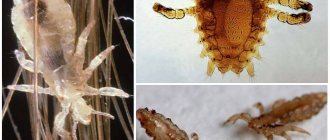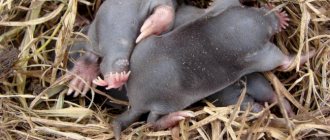What do real moles look like?
They are up to 15 cm long. The weight of an adult mole is approximately 120 g. The color of the animal is gray or brown. The wool is velvety to the touch. The fur does not have a specific direction. This leads to the fact that no matter where the mole moves, the fur will not bristle.
She usually molts 3 to 4 times in one year. The limbs have the appearance of five-fingered paws that look turned outward. The claws are powerful, allowing moles to easily rake the ground. These animals, due to the characteristics of their body, are able to dig underground passages over long distances.
Description of the appearance of cubs and adults
Their muzzle is elongated. The mole has 44 teeth in its mouth. The presence of fangs allows these animals to hunt more efficiently. In one day, the animal is able to dig an underground passage 40 meters long. Interesting. That in this case he will have to throw up to 500 kg of earth onto the surface. In his home, the system of passages is such that the tunnel can be up to 200 meters long.
The eyesight of these animals is very poor; moles navigate by smell. This is due to the fact that they are almost always underground, where there is no lighting. In addition, this animal has well-developed hearing.
Moles do not hibernate. They have an active lifestyle throughout the year. They are not accustomed to life in captivity. At the same time, they quickly die from obesity and a sedentary lifestyle. The fur of this animal is beautiful, but rather fragile. Therefore, it is practically not used. Babies are born naked, and after two weeks they are covered with fur.
Newborn moles
Dimensions of a small and adult individual
Adults are no larger than a human palm. Their weight can be from 100 to 170 grams.
At birth, cubs usually weigh up to three grams.
Types and features of appearance (+photo)
The European variety of moles is black. While in Russia there is a fight against it as a pest, in Europe it is considered a rare animal, which is listed in the Red Book.
European mole
Forest moles have red-brown fur. Sometimes it is gray-brown. The back is dark in color, and the belly is lighter. They prefer to live in gardens, but you rarely see them in vegetable gardens.
forest mole
Field moles are the most active pests. They have the characteristic sharp rodent snout and grayish-brown color.
field mole
Reproduction
The breeding process occurs every year, and the timing of gestation for each species is different. The Siberian mole is characterized by the fact that it has a period when the embryo freezes for some period and stops developing. That's why:
- European moles mate in March-April and offspring are born after 35-40 days. Cubs are born blind and naked. Each litter contains from 3 to 9 moles, which weigh no more than 3 grams. Some adults (up to 20%) can become pregnant a second time. After a month and a half, the young leave the nest.
- Siberian moles mate in the summer, but the female gives birth to young the following spring. In this case, the female’s pregnancy lasts almost 270 days. Each litter contains from 3 to 6 moles. Already in June they become adults and leave the nest. In this case, females become sexually mature only the next year, and males only in the second year.
- The blind mole mates in February/March, when there is still snow on the ground. After a month, from 1 to 5 moles are born. After a month they become independent and leave the nest.
- The Caucasian mole also mates in February, and mole babies are born in March. After 40 days, no more than 3 individuals will already become adults and independent.
Despite low fertility and reproduction only once a year, the number of moles on the site is increasing at a rapid pace. Due to the fact that moles live in the ground, no predators can reach them.
The lifespan of moles depends on their species, although we can safely say that their average lifespan ranges from 4 to 5 years.
What do wormholes and passages look like?
The presence of moles in a particular area can be judged by the appearance of the ground surface. At the same time, you can see a large number of cone-shaped slides of freshly dug earth. In the process of digging underground passages, the mole pushes the soil upward. The depth at which the animals dig holes is generally from 2 to 5 meters.
The mole spends most of its time digging holes and moving around them. This lifestyle requires a lot of energy and requires intensive nutrition. If the mole does not receive food for 17 hours, this will lead to its death.
One of the reasons why moles come to gardens is that there is cultivated and well-moistened soil in which it is relatively easy to dig underground passages. In addition, moles have their own natural enemies. Living in close proximity to human habitation, they have the opportunity to avoid them.
Living in the garden, moles leave much less traces, because the soil there is loose and there is no need to push it to the surface.
Molehole
Models
Despite the fact that it is very difficult to sew a mole fur coat, there is a huge variety of them on the product market.
Here you can find:
- classic cross-cut fur coat;
- short autolady;
- model with a hood;
- with three-quarter sleeves.
Of course, due to the length, the price varies greatly. And not every fashionista can afford to buy a long mole fur coat.
You can often find a cross-cut mole fur coat, and this is understandable. Because The skin of this animal is very small, so sewing it into a whole product will be very problematic.
But the cross-cut fur coat will be sewn not from a single piece of fabric, but from individual skins. This results in a product with even horizontal stripes.
Also, not only fur coats are made from mole skins, but also jackets, vests and hats. Because The animal's fur is quite cold, but very velvety and soft; it is often used to make collars.
Where do they live and what is their lifestyle?
Moles can settle in a summer cottage, but this is not their only habitat. In the wild, you can meet these animals in forest areas, as well as near places where people live:
- in the meadows;
- in the gardens;
- on the territory of parks;
- in other green spaces.
Moles prefer to dig holes in moist soil. If it is dry, it will make it difficult for them to dig tunnels. Therefore, they prefer to live in lowlands. Moles feed on earthworms, as well as other invertebrates that live in the soil. It feeds:
- root vegetables;
- grains;
- eat parts of plants;
- earthworms;
- insect larvae;
- centipedes, woodlice.
The largest portion of the diet of these animals consists of earthworms. This is explained by the fact that they are numerous and live everywhere. It can be argued that the mole, while moving through its underground passages, does not neglect any food that comes across its path.
Moles living in the forest feed not only on plants and insects living in the ground, but also on flies, wasps, ants, and insect larvae that they can find.
These animals also prey on mice or small snakes. Almost any creature that wanders into its hole can become its victim. The weight of food that one animal eats is equal to its own weight.
Enemies
These animals have almost no natural enemies. Birds of prey pose the greatest threat to them.
Reproduction
Reproduction occurs starting from March-April. Pregnancy is 40 days. One brood can contain up to 9 cubs.
The lifestyle of these animals is sedentary, but after their birth, young moles move up to 4 km from the place of birth. Their life expectancy is up to 5 years.
Reproduction
Sometimes moles break their solitary lifestyle to mate. Immediately after its completion, the male leaves the female. He does not help build nests for his young and does not participate in their upbringing. During the breeding season, females show increased aggressiveness towards individuals of their own sex.
Usually there is no more than one brood per year. The gestation period varies depending on the species from 30 (common moles) to 42 days (Eastern moles).
A new generation is born in nests. A brood consists of two to seven individuals. Initially they are naked and hairless, but after two weeks they become overgrown with fur. At three weeks of age, their eyes open. In the first month, babies' nutrition consists only of mother's milk. On the 35th day, moles leave their native nest and begin to look for a free area for themselves. During this period, many of them die under the wheels of cars or from predators.
Why are moles dangerous for crops?
Since moles massively destroy earthworms in the garden, the lack of the latter leads to insufficient loosening of the soil, which negatively affects the development of plants and their productivity.
Some plants die due to the fact that the roots fall into the mole entrance and remain, as it were, hanging in the air, not receiving nutrients.
What's the use
Moles eat mole crickets and beetles in the garden, which are dangerous insect pests. In addition, they feed on voles.
Medvedka
DIY repellent devices
You can make a structure yourself that will protect your area from moles. To do this you will need:
- plastic bottle;
- metal rod;
- part of a water pipe.
It is easy to make such a device.
- Hammer the pipe into the ground so that its edge is below the level at which the passages were dug.
- Place the pin on top of the part of the pipe that is driven into the ground. Secure the pin with a plug.
- Make a hole in the bottom of the bottle with a hot nail. Its diameter must be larger than the diameter of the pin.
- On the surface of the bottle, make 4 U-shaped slits on different sides and bend the plastic. Place the structure on a pin secured in a piece of pipe.
Homemade repeller diagram
The wind will spin the bottle in a circle like a weather vane, and the empty pipe will generate resonance and spread it throughout the soil, including dug passages. Moles are afraid of such noises and leave the territory without having time to master it sufficiently so that later there is a desire to return back. On a plot of 6 acres, 2-3 such scarecrows will be enough. Based on this, you can calculate the quantity if your area is larger. For example, 30 acres will require 10 such structures. But their cheapness and ease of manufacture are justified.
How to get rid of moles on the site
Various means are used to combat these animals:
- It is known that the smell of wormwood is very unpleasant for moles. Therefore, where it grows, these animals try not to appear.
- Another means of control is to spray garden bushes and trees with a solution that includes peppermint oil.
- If legumes are planted on the site, then this land will not be suitable for moles. The same can be said about planting onions and garlic. If you plant the borders of the site with these crops, then moles will not live there.
- It is believed that if you plant the imperial hazel grouse, it will help get rid of these animals.
- An effective means of controlling moles is the use of traps. A dog can help you install them correctly. The smell of mole enzymes is very unpleasant to them and they can distinguish the smell well. The dog will help you find the exit of the wormhole to the surface. Usually it is covered with earth. Therefore, before installing a trap, you need to remove a pile of earth above the surface and dig a little deeper into the hole. You need to install a trap at the exit from it. Since this passage is dug, the mole will feel a draft and will come to cover the exit from the hole with earth. At this moment he will fall into a trap. If the hunt for the mole ended successfully, then it may still be alive. If a mole hunter adheres to humane views of them, then he has the opportunity to take the animal and take it far into the forest or field and release it there. If the mole is dead, then it must be buried. This must be done away from sources of drinking water.
- Another option to get rid of moles on your property is to use sound repellers. There are two options for such devices:
- reed;
- using plastic bottles.
In the first case, you need to do the following. You need to cut the reeds in such a way that you get a segment of one and a half meters. In order to install it correctly, it is necessary to determine where the wormhole runs. Then you need to install the reed vertically so that the lower end falls exactly into the mole passage.
In this case, the upper part should remain above the ground. Its length should be approximately half the reed. If windy weather begins, sounds will be transmitted inside the mole tunnel. For these animals they are very unpleasant. This way you can drive moles out of your area.
Another version of the “sonic weapon” can be made using plastic bottles. Holes are made in them into which metal rods are installed. The latter are immersed in the ground in such a way as to fall into the wormhole. During strong winds, this structure will vibrate and make sounds that will fall into the hole. Such sounds are unpleasant for moles and will gradually force them to leave.
The industry produces chemicals to combat these animals. Usually their use can produce a quick and effective effect.
However, when deciding on the use of such products, owners must take into account that they contain phosphorides. Such substances can have harmful effects on the soil. Therefore, you need to weigh the benefits and harm received from such means before resorting to them. In addition, the use of phosphorides will also be dangerous for other warm-blooded animals, not just moles. If the farmer has them and can get into the cultivated area, then such animals will be endangered.
The use of chemicals to combat moles occurs in the following order. First you need to determine exactly where the mole tunnels are. Chemicals are placed where their exits are located.
For this purpose, you can use the Nutcracker product. It has a reputation for being a very effective way to control moles. This drug looks like a thick and viscous substance, which is poured at the mole exits onto the surface of the earth.
Watch the video on how to remove moles:
Interesting Facts
Despite their “banality” and familiarity, moles are a unique family that is interesting to both scientists and ordinary people.
People may not know everything about moles, but they have collected a number of facts about them:
- In construction, the mole uses not only its paws, but also its nose.
- In one minute the animal digs up to 30 cm of soil.
- Sometimes moles eat their dead or weakened relatives.
- The speed of movement of the animal through the tunnel is 25 m/s.
- There is a bone in the reproductive organ of male moles.
- Moles are not actually blind; their eyes are simply covered with skin to prevent dirt from falling into them.
- Moles, along with snakes, are never found in Ireland.
- Even if the animal is moved to another place, it somehow still finds its way home.
- The average length of a mole hole is 200 meters.
- Ordinary moles are not found in Australia, and their ecological niche is occupied by marsupial moles - animals with orange fur.
- If you start feeding the animal artificially, it will stop moving and will soon die from obesity.
- Golden moles (golden moles) living in South Africa are not moles.
The mole is a very peculiar animal that brings both harm and benefit to agriculture. Its lifestyle is typical for an underground animal, although it has its own characteristics. There are more than 40 species in the Mole family, many of which are found in Russia.
Fighting moles using sounds, soil and unpleasant odors.
Moles can create a huge number of problems for land owners. Killing moles with a shovel is not a humane method.
But you can dig a hole. You need to pour more earth into the hole or passage. The mole will definitely dig out. It’s easy to notice – a mound of earth appears. Then you need to take a shovel and dig out the animal. In this case, it is important to get ahead of the small animal, because the mole digs the ground at high speed and it is necessary to keep up with it. You need to try to throw the mole out with a shovel.
A good method to scare away moles is to use an ultrasonic repeller.
This repeller is charged from the sun. You need to try to place the equipment next to the animal’s burrow and direct it into the passages that the mole made. Such a repeller can force the mole to leave its home, and possibly even leave the area completely.
In addition to irritating sounds, the animal is irritated by sharp and unpleasant odors.
Some summer residents use rags soaked in kerosene, pour tar powder, carbide and any strong-smelling substance into the passages. Water the top with plenty of liquid and plug up the holes made by the mole.
Some gardeners
Desperate to expel a mole from a site, they may bury rotten eggs, fish heads and other foul-smelling waste in the soil. This method can help, but the owner of the site will also have a bad time.
Folk remedies
Homemade windmills made from reeds, champagne bottles, plastic bottles and cans
To effectively repel moles, you can build your own windmills from scrap items.
For a long time, reed stems have been used for these purposes, which are hollow inside, and therefore create a characteristic scaring sound in the wind. One reed should be inserted into each mole hole. This will create the effect of a wind tunnel, which will begin to create sounds of certain frequencies even with minor gusts of wind.
To effectively repel moles, you can build your own windmills from scrap items.
Using empty plastic bottles with a capacity of 1.5 to 2 liters, or glass champagne bottles, you can easily create a structure that repels moles. In addition to the bottle, this will require a metal tube that fits the diameter of the bottle neck. One end of the tube must be firmly buried in the wormhole, and a bottle must be placed on the other. The deterrent effect is achieved through the noise generated by air entering the bottle and metal tube.
Using empty plastic bottles, you can easily create a structure that repels moles
An ordinary beer or Coca-Cola can can also be useful for creating a simple mole repeller. All that is necessary is to put it on a metal tube previously dug into the wormhole. A more pronounced effect can be achieved by cutting characteristic blades into the body of the can. Thus, with every gust of wind it will spin faster and rumble louder.
Smell repellent: kerosene, ammonia, rotten fish
Unpleasant, pungent and irritating odors are no less effective in combating pest animals than loud sounds. To do this, you can place a piece of rotten fish inside the animal’s hole, or spray the entrance to the home with ammonia or kerosene. Since the mole’s sense of smell is very developed, this method will force the animal to leave its house.
Appearance of the animal
The appearance of the animal is more similar to mice than to rats:
- rounded body, large head with a blunt muzzle;
- small round ears, barely noticeable;
- the eyes are round and large enough;
- massive paws with long toes and slightly rounded claws.
There are still differences between rats and mice. The rodent's body length is about 22 cm. The tail is narrow, long, covered with thick, hard hair. There is a small brush at the tip. The coat is soft, but there are long, stiff fibers throughout the body. In winter, the cover becomes denser and fluffier. The weight of the animal is about 350 g.
The color of the ground rat depends on its habitat and age. The back is always darker than the sides. Mainly brown with tints of different tones of brown.
The abdomen is dirty white. Available in red or completely black. The yellow earthen rat looks like a hamster. The only thing that gives it away is its long tail and the absence of a light stripe along the back. A photo of an earthen rat is presented below.
Preventive measures
In order not to subsequently fight moles on your site, you should take preventive measures that will help prevent the appearance of animals. One method is to fence the dacha area around the entire perimeter. To do this, you will need to bury roofing felt, slate, sheets of tin or metal mesh into the soil to a depth of 1 meter, but so that another 30 cm of material remains above the surface. The joints of the sheets must be sealed very carefully so as not to give the insectivore a chance to get inside. The method is quite labor-intensive, but it allows you to get rid of uninvited guests forever.
Another method of prevention is easier to use. Experienced gardeners claim that by planting plants at the dacha along the entire perimeter whose smell the mole cannot tolerate, you can completely prevent its appearance on the site. These include: marigolds, castor beans, imperial hazel grouse, decorative onions, garlic, beans, peas, black beans, Siberian scilla, daffodils.
Source
Nutrition
Females are caring mothers who carefully look after their cubs. Initially, mole babies feed on milk, quickly gain weight, and develop. In about a month, teeth grow, claws grow, the cubs switch to solid food - grain, seeds, roots, insects, earthworms.
At the age of 1.5-2 months, the cubs become independent and are capable of killing a mouse, frog, or snake. The matured young animals behave aggressively towards each other; after 60 days of their existence, each of them begins to build their own burrow with numerous labyrinths.
Baby's diet
The baby mole feeds several times a day. Food is digested in approximately 5 hours. Between breaks in food, the animal sleeps in a special “room” curled up in a ball.
Basic diet:
- earthworms;
- caterpillars;
- woodlice;
- May beetle larvae;
- slugs;
- snails;
- mole crickets;
- spiders;
- centipedes.
Occasionally they eat vertebrates that are in a sedentary state - mice, lizards, snakes, frogs. In a hungry state, an animal can live no more than 17 hours.
Purpose
A mole spends its entire life in a hole. Horizontal and vertical labyrinths are located at different depths. The tunnels intersect with each other and have many exits and entrances. Nora looks confused.
The depth of a mole's hole reaches 2 m. How wide the tunnels are can be judged by the number of tubercles above the ground.
- Tunnels for searching for food are placed approximately 15 cm below the soil surface. The animal feeds on earthworms, bugs, roots, plant seeds, root vegetables, and grain.
- The bedroom is located at a distance of 50 cm from the ground surface. It is small in size, covered with straw, grass, and various twigs. By winter, the animal moves to a room that is located at a depth of at least 1 m.
- Deepest of all are the storerooms where the mole stores supplies. Despite its small size, the animal has a brutal appetite. During the day, he eats an amount of food equal to his total weight.
The photo of the mole hole is located below, where you can see numerous tunnels, passages, exits, storage rooms and sleeping places. The mink protects from attacks by enemies, unfavorable external conditions, and ensures normal life functions of the animal.
Mole hole underground
Eliminating moles using traps and traps. Mole baiting.
If the above methods do not help, then the mole must be caught.
You can catch moles using a trap or trap.
True, several traps and traps need to be installed. And for this they dig another passage, which creates a draft. Traps and traps are installed throughout the entire area, since the animal does not sit still but examines the entire perimeter.
You can use the method of poisoning the animal.
To do this, they take an earthworm, cut it and insert poison into it. The poisonous worm is pushed to the bottom of the mole hole and the mole's passage is filled with earth.
It will also help to destroy earthworms in the area and everything that a mole can feed on.
Treating the area with a soap solution at the very beginning of the season and at the end will help destroy earthworms.
You can dig a mesh or slate across the area.
This will prevent animals from moving around the area.
It is not recommended to use chemicals yourself. The gardener may not calculate the dose and harm other plants growing on the site. The gardener can also harm himself.
Acoustic methods
Purchased ultrasonic repellers
Ultrasonic mole repellers are widely available, which are both highly effective and humane.
Ultrasonic mole repellers are widely available
The operating principle of these structures is based on the supply of a special signal, which is amplified under the influence of a motor. Modern electronic ultrasonic repellers are capable of operating within a radius of 40–45 meters. However, for maximum efficiency, there should be no voids or large-scale obstacles on the territory. To ensure the highest sound quality, it is necessary to place the device as close to the ground as possible.
Vibration devices
Vibrating devices for repelling moles operate primarily on solar energy batteries. Their design is an elongated aluminum rod topped with a peculiar cap. Immediately after being fixed in the ground, the device begins to generate high-frequency waves, which have a very painful effect on the mole’s auditory organs. The animal takes the vibration created as a danger signal, and is therefore forced to leave the area.
